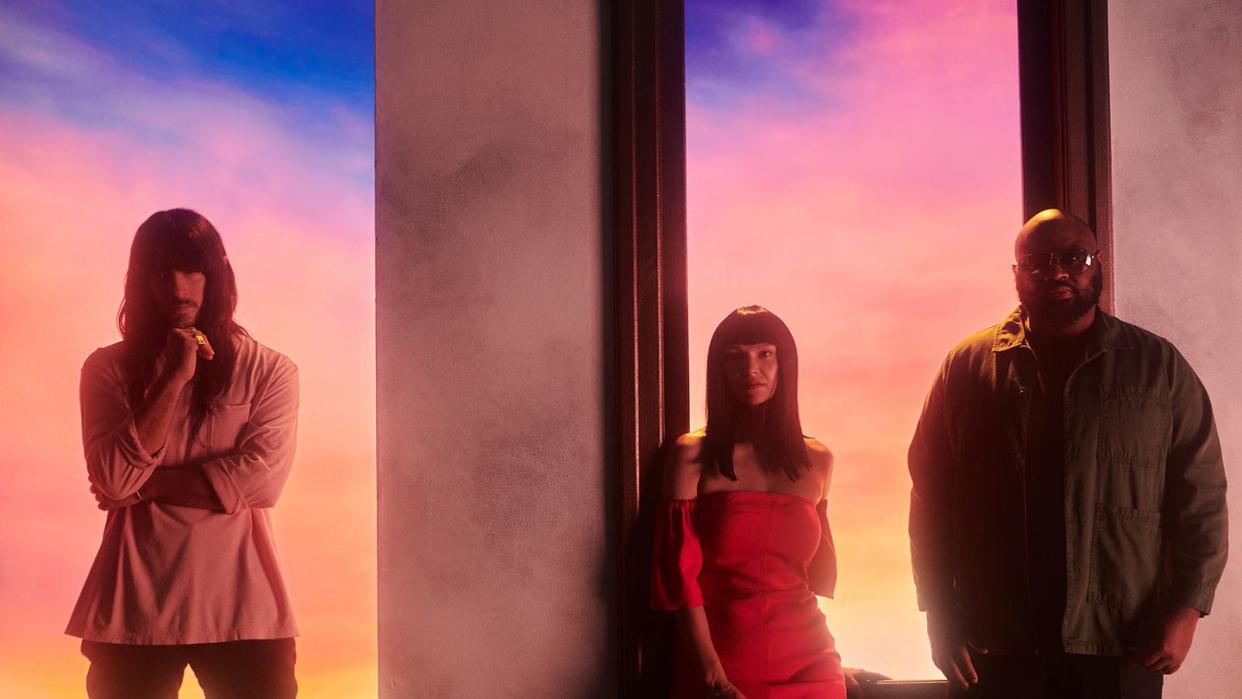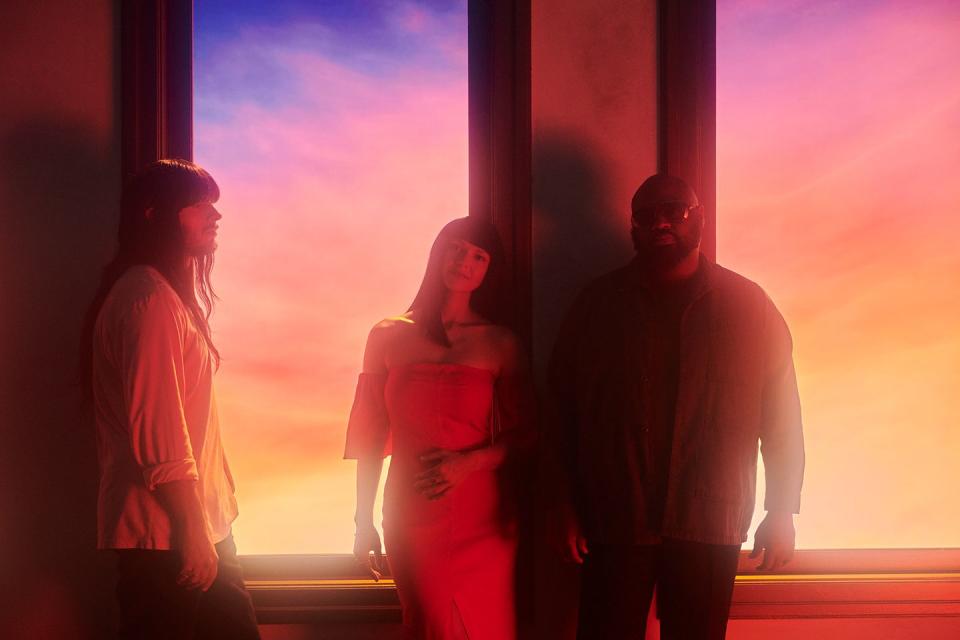The Global Comfort of Khruangbin

"Hearst Magazines and Yahoo may earn commission or revenue on some items through these links."
“Getting the band back together” isn’t the first phrase you might associate with a group like Khruanghbin. Between 2022 and 2023 alone, they released six albums. They’ve sold out Red Rocks and Radio City Music Hall, each twice respectively, and have played festivals on five continents. They’ve been on 18 tours, have sold somewhere around 384,000 concert tickets, and as of this story, their total number of streams is nearing 800 million.
The funk-rock trio has a devoted cult of fans, who have lifted them to omnipresent indie-great status. Any modern, engaged music listener is likely to know the name, regardless of whether or not they can pronounce it, or even place it. Their tailored neo-nostalgia is just as likely to seep out of the speakers at a buzzed-about restaurant, as it to manifest out of the haze of a dorm-room speaker mid-trip. On April 5, they released their fourth studio album A La Sala. But, Laura Lee — the group’s criminally cool bassist — still describes the record as the band’s return.
“It was really important for me personally to reconnect with Mark and DJ and reconnect with myself at a simpler time within the band,” she says of the album, referring to guitarist and producer Mark Speer and drummer DJ Johnson.
And a closer look at the band’s numbers aligns with Lee’s sentiment. Three of the four live albums they released in 2022 were performances played in conjunction with other, equally impressive bands (Toro y Moi, Nubya Garcia, Men I Trust), and their top streamed album, 2020’s Texas Sun, is one of two collaborative EPs with Leon Bridges. Much of their work has included partnerships with others, leaving the original three members less time together, or more aptly-put, less time to be alone-together.
“I think we wanted to let go of all the crutches that we carry. There's a security blanket aspect of saying, ‘Well, we can fill this with a guest spot, right?’” Lee explained.
Put more pointedly, the dissolution of what felt like the band’s simpler days was a byproduct of their rising star: an archetypal tale of corporatism’s often-clouding effect.
“We've had a lot of meetings, like press meetings, management calls, agent calls, stage production calls. And it's so amazing how other people's voices, these strong voices, start to carry the band in different directions," Lee says. "But it's actually the three of us, and it's really important to look at each other, hold each other's hands and say, ‘Is this what we want?’”

A La Sala became an overall return to basics, and fighting the aforementioned urge to add: including collaborators, instruments, and technical recording aspects. “We stripped. There are less gadgets, less effects,” Lee explains.
And the urge to include is very Khruangbin. It’s part of their global appeal. On A La Sala, “Todavía Viva'' has Lee’s signature no-nonsense, deep, plucking bassline and Johnson’s unfathomably deft groove situated into a Roy Ayers-like instrumental (a noted influence of the band), whereas “May Ninth” breathes a melodic folkiness into the record, complete with a quiet bottom layer of outdoor field recordings —collected by Lee and Speer — for additional atmosphere. Lee’s love of the eponymous 1969 collaboration between Jane Birkin and Serge Gainsbourgas comes through in her casually alluring, soft vocal deliveries. There’s also brief moments of surf rock on tracks like “Juego y Nubes,” and Western-style cowboy chords poke through the nostalgic hum of a record player’s fuzz on the album’s opening track “Fifteen Fifty-Three.”
Lee appropriately likens their sound to chicken soup: “I think every culture has a version of mom’s chicken noodle soup. It’s the ultimate comfort.” In general, Khruanghbin’s super power as a band is their ability to distill a world’s worth of influences into music that doesn’t sound tedious, overworked or overthought. Perhaps most importantly to their success, it’s unalienating.
Lee points to the work of surrealist painter René Magritte’s as a reference, famous for works like The Son of Man, in which a business-clad subject faces the viewer directly, his face obscured by a green apple. “It’s surreal in this strange combination of subtle and mind-expanding,” Lee says of Magritte. “You almost don’t notice it.” A not insignificant portion of Magritte’s work hangs in the Menil Collection in the band’s hometown of Houston. “ I personally spent hours and hours in that museum, both as a visitor and as an intern, staring at his works,” Lee says.
Like most art that appears simple on its face, Khruanghbin’s subtlety is the result of over a decade’s worth of dedicated work. The band officially formed in 2010, after three years of Tuesday hangouts at Houston’s Rudyard’s pub, a dive bar that Lee describes as having “a British sensibility, but located in a very neighborhood setting.” Speer and Johnson would meet Lee after their weekly rehearsals at St. John’s United Methodist Church, most famously known for its members Beyoncé and Solange Knowles.
“We're very much siblings,” Lee says of her bandmates. “I trust them with everything.”
The grounding effect of the music is born out of a similarly grounded recording style. Speers — the lead guitarist who has also produced every one of the group’s studio albums alongside producer Steve Christensen — runs a tight ship. “He’s really good at making sure something can’t be more unique. He wants to make sure not a single note sounds stock.” Lee laughs a little, explaining that it’s a technique pulled from the 2004 Metallica documentary About Metallica: Some Kind of Monster, in which the group’s drummer Lars Ulrich tentatively picks his words before describing a song’s guitar as “a little stock.”
Johnson, the group’s own drummer, brings everyone back. “He’s home base,” Lee says. The YouTube comment section of the band’s 2018 Tiny Desk performance is a treasure trove of testaments to Johnson’s inimitable anchoring ability. “Drummer adjusts half a beat after every 5 millionth beat to compensate for earth's equinox tilt,” one comments. “I heard this drummer got lost in the wilderness with no phone or watch and when they found him 3 years later he knew what second it was,” another quips.
As for Lee, some of her most notable contributions actually stemmed from her absence. She was eight months pregnant during A La Sala’s recording process. “[The baby] was kicking sometimes during the recording sessions, and I was kind of like, ‘Could you kick in time?’” she jokes.
Lee’s midwife gave her a strict recording deadline, meaning there were a few final sessions when she wasn’t present. “For those weeks that I was home, I was the perspective person. They would be working for hours, and then send it to me, and I wouldn't know what they had changed. So I could come back and say, ‘This sounds great,’ or ‘This doesn't.’” After years of work, the member’s respective contributions have created an overall sonic equilibrium.
This spring, the band will bring A La Sala on an international tour, marking their 19th tour together. Lee credits fellow indie rocker and mom Charity Rose Thielen from The Head and the Heart for her advice on touring as a mom, including gear recommendations and logistical advice.
For listeners who can’t catch Khruangbin on their official tour this summer, the band will also hold a handful of listening sessions at various James Turrel sky spaces, where the celebrity-favorite artist combines refracted light and nature to give each viewer their own unique chance to “give form to perception.”
When asked about the ideal setting to listen to the album, Lee puts it perfectly: “It’s like a choose-your-own-adventure. Adventure is best chosen by the adventurer.”
You Might Also Like

